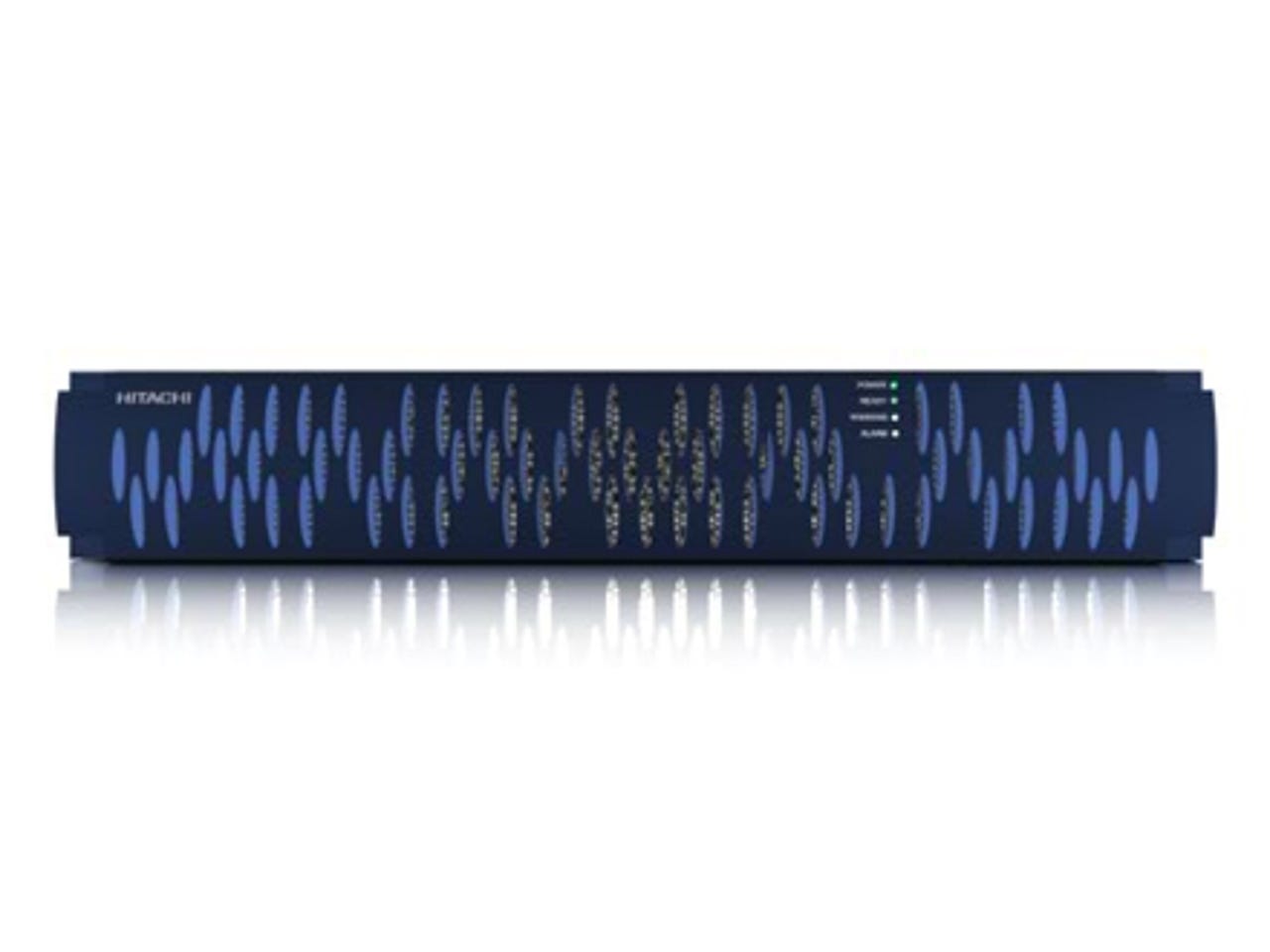Hitachi SMS100


Launched in December, the Hitachi SMS100 is a mid-range iSCSI storage system available in several storage capacities built from SAS or SATA disk drives. Every version has dual power supplies for fault tolerance, and single and dual RAID controller versions are available. Two RAID controllers provide the best fault tolerance, as one controller would take over the work of the other in the event of a fault.
One of the most interesting features of the unit is its auto migration feature, which should make it straightforward to swap out a faulty unit. Equally notable is a 'Data shredding' feature, which would completely erase all data from the array so it could be returned to the supplier following a swap out.
The chassis has two hot-pluggable slots for optional hot-spare drives. However, the disk drives used during normal operation are sealed into the unit, and we are a little disappointed that system administrators cannot replace these drives if they develop a fault, or increase the storage capacity by adding more disks to the chassis. Nor could they swap out a faulty RAID controller or add a second one if they originally purchased a single controller version. A unit with more than two failed disk drives or another hardware fault would need to be swapped out for a replacement. This would be relatively easy thanks to the auto-migration feature, and would be free of charge while under warranty, which normally lasts for three years. Maintenance and upgradeability by storage administrators are hardly features of the SMS100.
RAID 6 is used to provide a high level of fault tolerance. This uses two disks for parity data, so the unit will carry on working even if two disks have failed. However, with such huge storage capacities available from such a small number of disk mechanisms, it would probably take many hours if not a few days for the array to rebuild the data from a faulty drive onto the hot spare. Rather than being overkill, RAID6 is used to maintain fault tolerance while the array completes this process. We tested the six-drive version of the SMS100 configured with 146GB SAS drives, which provided a total storage capacity of 531GB.
A built-in web server provides a simple overview of the hardware, but it cannot be used to configure the unit. Instead, the SMS100 is managed remotely using Hitachi's Storage Navigator Modular 2 (HSNM2) management suite, which must be installed onto a separate PC.
Each RAID controller has four network interfaces, one of which is for connecting the management PC to the RAID controller. Two other network interfaces are available for iSCSI traffic, and the fourth is a maintenance port for Hitachi technicians.
New units are delivered with each management interface configured with a static class C private IP address. Users must set the IP address of their management PC to the same subnet before installing the HSNM2 software. All this is covered in the Quick Install Guide, but the unit would be more tricky than some others to setup without reference to the documentation. In our tests we found we could not set the management IP address to use the same IP subnet as the iSCSI interfaces, which was a little inconvenient for our test environment but would probably not be an issue for most customers.
We were also a little surprised to see that a new installation of HSNM2 consumed almost 1GB of disk space, but on the upside it's a web based management system, so having installed it on one PC other people should be able to use it from their own desktops.
Hitachi's Storage Navigator Modular 2 (HSNM2) Add Array wizard.For our tests we simply launched our web browser and pointed it to the IP address of our workstation. After entering the appropriate username and password, a new browser window opened showing the basic HSNM2 console. As this was the first time the console had been used a second browser window opened with the Add Array Wizard, which asked for the SMS100 controller's IP addresses and brought the units under the control of our HSNM2 suite.
HSNM2 performing the initial configuration of the SMS100.With the array added to the suite, another wizard helped us perform the initial configuration, which included setting the final IP address of the controller and iSCSI interfaces, and configuring email addresses that the array would use should it decide to send a report to a storage administrator. There was also an option to configure the time and date.
Once the array had been configured for our network, we used HSNM2 to create a LUN (Logical Unit Number) for our tests. We then added the IP address of one of our controllers into the Windows iSCSI Initiator software on our test workstation and were quickly able to configure it to use our SMS100 LUN.
As this was a freshly created LUN, we needed to use the Windows Disk Management tool to format the LUN with the NTFS filesystem before we could copy data to the SMS100. For our tests we used a desktop PC running Windows XP Professional Version 2002 SP3 and fitted with a 2.8GHz Intel Pentium 4, 760MB RAM and an onboard Broadcom 440x 100Mbps NIC. It took about one minute to copy a 50MB file to the array from this desktop PC. We would expect a modern server fitted with multiple CPUs and gigabit-speed network cards to get better performance from the SMS100.
Overall we were impressed by the HSNM2 software. It uses the popular twin-panel user interface to show a list of options in the left-hand panel and a detailed view of the selected option in the right-hand panel.
HSNM2's iSCSI Targets page has an entry for each controller interface.For example, the iSCSI Targets page had an entry for each controller interface, and we could click on a controller to see a list of the LUNs assigned to servers by each controller. Similarly, the Settings page had a list of pages for reconfiguring the array. We could use this page to expand LUNs, update the array firmware and adjust iSCSI settings. This page also had link to the Replacement of Array function, which is used to access the auto migration and data shredding features. Unfortunatel we were only supplied with one SMS100 so we couldn't test the auto migration feature.